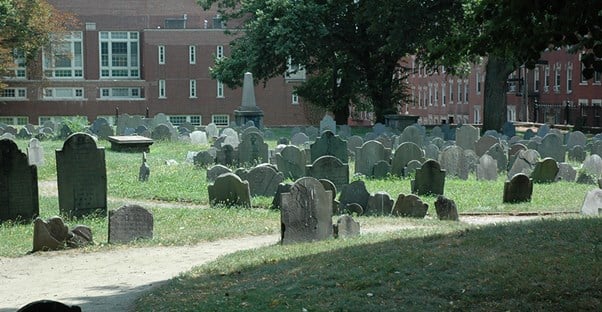10. Salem, Massachusetts

Salem, Massachusetts, is a weird blend of atmospheres, where whacky Halloween carnival fun meets a history of actual, brutal murder! This was also one of our "vacations that involve dead people" destinations, but it's weird enough to bear mentioning again. There was this cool way of telling whether a woman was a witch where you would submerge her in water and if she survived, she was. If she drowned, turns out she was innocent! Pretty cool, right?!
9. Hyde Park, London

Hyde Park is one of the largest parks in London, and it's an absolute joy to behold. The park is a veritable oasis of calming green amidst the otherwise bustling Westminster streets. It was also the site of two bombings linked to the IRA, and is believed by some to be a prowling ground for Jack the Ripper—the bodies of his confirmed victims were all found about four miles east in Whitechapel. If you want extra willies, take this map and wander around the neighborhood.
(image via Flickr)
8. Galveston, Texas

Galveston is actually a beautiful place, a fantastic beach, and a wonderfully affordable getaway. What puts it on this list is an architectural oddity that carries over from tragic events. Most people probably remember when Hurricane Ike made landfall in Galveston during 2008, ultimately causing some $25 billion in damage across several states. But as devastating as Ike was, the one that haunts the city most is the 1900 hurricane that claimed between 6,000 and 12,000 lives. After that, the entire city was put behind a seawall and elevated onto stilts—including a 3,000-ton church. The stilts serve as a constant reminder of the storm and of the fact that we find a way to press on in the face of so much loss.
(image via Flickr)
7. Trail of Tears

Call it a "forced relocation" or call it a "death march." Either way, it wasn't pretty. Andrew Jackson's removal of American Indians to Oklahoma claimed the lives of some 2,500 Choctaw, 3,500 Creek, and over 4,000 Cherokee as disease and food shortages took their toll over miles of moving families on foot. Their paths across nine states are marked today. Ironically, now they seem to be an oasis of calm and green, away from the pressures of city life—just as long as you don't think too hard about where you're standing.
(image via Instagram)
6. The Underground Railroad

We all remember the first time we realized that the Underground Railroad wasn't an actual railroad, but that doesn't mean that parts of the network haven't been preserved. Across 24 states and the District of Columbia, you can visit monuments to the abolitionist escape route. While it's a more silver-lining approach than visiting Gettysburg or a plantation, it's still pretty sobering to know that where you stood, families huddled close, balanced on the precipice between barely-dreamt-of freedom or a lifetime of brutal servitude.
(image via Flickr)
5. The Tower of London

The Tower of London is an icon of all things British. The crown jewels are kept here, along with the guards who have funny hats and museum placards about what life was like way back when the tower was used a fortress. But it was also a prison. Anne Boleyn was executed here, and Guy Fawkes was tortured at this location. Just north is Tower Hill where most of the executions took place, including the martyrdom of Sir Thomas More. All in all, there were 122 confirmed executions from 1388-1780, and considering how hard it is for paper records to last 650 years, there were probably many more we don't know about.
(image via Wikimedia)
4. Place de la Concorde, Paris

You can't really walk anywhere in Paris without stepping on ground that saw bloodshed during the French Revolution. One in every 50 people in France was thrown in jail, and around 40,000 of those were executed. Place de la Concorde in Paris was a really special spot where the guillotine was always swinging. King Louis XVI, Marie Antoinette, and eventually Maximilien Robespierre were all executed here.
(image via Wikimedia)
3. Boston's North End

The North End of Boston is a great historical site and home to some of the best Italian food in the country. There are so many landmarks here, from the Old North Church to the Paul Revere House, that it's easy to forget about the weird tragedy that struck here in 1919. The Great Molasses flood started when a 50-foot tall storage tank ruptured, spilling 2.3 million gallons of syrupy gunk onto the Boston streets, demolishing buildings, killing 21 people and injuring another 150 as people were drowned and smothered in sugary goop. There's a memorial plaque in place, and the site is now a playground.
2. The Great Wall of China

The Great Wall of China is an architectural marvel and a beautiful sight to behold. It's also a testament to how much you can accomplish when you don't care who you step on. So many workers died building the wall that they just started using them as building material, in the grimmest two-birds-with-one-stone situation that the world ever saw. To greatly paraphrase Louis C.K., it's amazing what you can accomplish by throwing human suffering and death at a problem until it's solved.
(image via Wikimedia)
1. Round Rock, Texas

It may come across as cheating to include Texas on the list twice, but Round Rock is home to a singularly unique tragedy—the filming of the fourth Transformers film. Did we really need four Transformers movies? And even if we did need four of them, did we need the four that we got?
(image via Wikimedia)
 Author
Garrett Steele
Last Updated: April 27, 2016
Author
Garrett Steele
Last Updated: April 27, 2016
